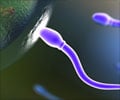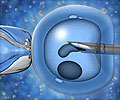Scientists have fertilized the eggs of mouse with artificial sperms from embryonic stem cells.
Scientists hoping to find a solution for male infertility have in an experiment for the first time ever, produced and used artificial sperms to create a living being (mice).
Professor Karim Nayernia and team, from Georg-August University, Gottingen, Germany, have created artificial sperm in a lab from the mouse embryonic stem cells. Professor Nayernia, who has now moved to the Newcastle-Durham NHS Institute for Stem Cell Biology and Regenerative Medicine this month, had earlier said, "For the first time we have been able to produce sperm in vitro, and use these sperm to fertilise eggs and get live births in animals."The scientists have fertilised mouse eggs with sperm grown from embryonic stem (ES) cells to produce seven pups, thereby proving that working reproductive cells can be prepared in the laboratory. The experiment and the successful births have now provided the most conclusive evidence so far on the possibility of eventually using stem cells to treat infertile men who can make no sperm of their own.
Previous experiments that were conducted had suggested that the artificial eggs could be made from female embryos, which had raised hopes for infertile women, although no offspring were born. The scientists hope that in the longer term, it might be possible to create sperm from female stem cells, and eggs from male ones, which could allow homosexual couples to have children bearing the genes of both parents. In theory, the scientists propose that a single person might even provide both the eggs and sperm needed to create an embryo.
They did however clarify that the creation of 'male egg' and 'female sperm', could however, face many a difficult barriers, as embryos generally require genetic material from both, mother and father so as to develop normally. The researchers hoped that the immediate benefit of the research would be a deeper more complex understanding on the formation of the mature sperm, and improved treatments for male infertility. A very promising idea already in the minds of the researchers is to remove tissue from the testes, culture immature sperm in the laboratory and then transfer them back to the patient.
The scientists hope that maybe in future it could become possible to clone embryos carrying the fertility patient's gene to be grown into the artificial sperm or eggs that might allow the patients to have their own genetic children. It was reported that even if the technique of cloning proves not to be viable, the technology should be able to solve the shortage of donated sperm and eggs.
The study, published in yesterday journal Developmental Cell, reported that Professor Nayernia, and his team had first created male mouse embryos, which were allowed to develop for a few days until they became small balls of cells known as blastocysts. Then identifying the cells that develop into the sperms, called spermatogonial stem cells (SSC’s), they removed them for culture. Picking the cells that formed sperm, they were injected into mouse eggs and the embryos that were then formed placed in the wombs of the surrogate mothers.
It was reported that though the fertilisation was not very efficient, as among hundreds of eggs that were injected, only about 50 developed as far as two-cell embryos, and only seven were carried to term. It was also reported that one of the pups had died in infancy and all the rest died within five months, as compared to the normal lifespan of about two years.
The researchers stated that this limited success has however proved the principle that they can lead to live births. Stating, "This is a problem we will have to solve before human trials, but it is a very important result from a biological viewpoint," Professor Nayernia said, "We have a model for studying how life begins."
Earlier a team at the University of Sheffield had already established that it is possible to grow human sperm from ES cells, though they made no attempt to use them to fertilise eggs. Other studies conducted in US and Japan have also shown that mouse eggs can be made from stem cells and fertilised, though there were no births of any pups.








